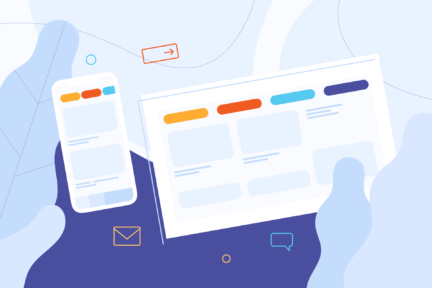So, you want to develop a mobile application for your business. Good thinking! Perhaps you even have a general idea of how you want that app to look in the end. The only problem is getting started. Choosing the right mobile app development company, deciding on all the tech specs, running a market and product research… There’s a lot to do!
The good news is that with a really good team of developers backing you up, you don’t have to worry about any of those things.
Mobile app development process in 6 steps
We’ll guide you step by step throughout the entire mobile app development process – from creating your mobile app development strategy to realising your custom digital solution. Read on!
First and foremost, you have to be armed with a well-thought-out vision of your final product. It must resist all the crucial faults, have a well-researched target audience and a market-oriented standpoint aligned with your business goals. With that said and prepared, you can start reaching out to app development companies.
Let’s say you browsed through our very own website and considered Miquido for your development purposes. Then, you might have discovered we can even help you out with product strategy planning and alignment! But that’s a topic for another day. Today, let’s focus on mobile app development.
Here’s the process that got us recognised by Google itself 😏
First things first. You need to estimate if your idea is aligned with your budget. Every semi-serious development agency will want to know how much money a client is willing to spend. In order to get a realistic quote, you need to think through at least the most basic features you want for your app.
Do you want it to be translated into different languages? Should it work on iOS and Android? Are you looking for just a mobile app or a web app too? You need to have answers to all these questions in order for the development team to be able to provide you with estimated time and resource requirements.
Next, you’ll have to think about functions, user data and integrations. Do you want your application to be integrated with other mobile apps or devices? Will it require a user to log in or to follow certain data protection guidelines? Are there any must-have features you’d like to see implemented in the first version? You see where we’re going with this.
The very first stage of our mobile app development process is fully dedicated to getting to know you, your business, goals, wants, and needs. This is when we see if working together would be beneficial for all the parties involved, answer all the crucial questions, and lay the ground for more advanced tasks.
You may have heard that 9 out of 10 of our orders come from referrals. And that’s not just catchy marketing buzz! The key difference between Miquido and other software houses is our client-centred approach dedicated to building long-term relationships. So it’s very important for us to have a real connection with our clients from day one. Whether it is because of the outstanding idea, an innovative approach, or simply a decent human connection – we want to create a friendly and fruitful work environment. That’s how we get great results later on.
Well, now you’re officially on board! Workshops constitute an essential part of the Miquido process. Not only do they help us get on with the execution faster, but they also ensure you, as our business partner, are fully engaged every step of the way.
We don’t want to confuse you with a bunch of technical buzzwords while you’re sitting idly hoping for the best outcome. We want you to understand exactly what we’re doing at every given moment, why we are doing it, and why it’s worth paying for. Such workshops help answer core business questions, identify the most important features, analyse the market, and deliver a primary project scope.
The best part is that every MVP workshop session is perfectly customisable. We dedicate them to your needs, which is why they really differ from one client to another. Generally, our workshops take up to 4 hours for each session and can be performed during one or two days – depending on your disposition and needs.
During this time, you and the development team will build a concept map, define the IT tech solutions to implement and research the tech environment that you could operate in.
If during the previous two steps we were closely working together, this time our team will take care of the main action. Based on your vision and strategy, together we will create a very basic prototype of functionalities and UX-based designs of your app, a core, that will be your guideline along the process.
Here’s some exciting news – by now we’ll be able to determine the scope of your project, plan the development schedule, assess the tools for management, etc. At this stage, all the primary functions and features of the product should be defined and paired up with technical solutions.
Now, the team can move on to wireframing and building a basic structure of the product.
Wireframes are very simple prototypes of your solution, a basic mobile app design that will illustrate how your application can be navigated and how it will feel for users in the future. Thanks to the wireframes, we can test usability and functions as well as some of the key design elements, etc. Moreover, wireframes allow us to catch some potential malfunctions early on.
How long it takes to develop a mobile app
Both scoping and wireframing will help you create a detailed product and see if it aligns with your business goals. It shouldn’t take more than a few weeks to estimate the scope of your project, come up with the wireframes, and prepare a minimum viable product. But then, development comes into play.
Be ready for it to take some time. We’ve already explained that there’s no universal formula for deciding how long it takes to develop a mobile application in one of our previous posts but be prepared for the entire process to take no less than one month.
Now, you may be wondering what happens next. How do we proceed with making your mobile app? Will the process be understandable, since it takes place in a technical environment that you may not be really familiar with?
If you choose a professional team then you shouldn’t worry. For example, at Miquido you would have a dedicated team of developers, a Project Manager, and a Product Owner. You can contact either one of them and be sure we will do our best to help you out.
This way you never have to worry about being left in the dark. So, if keeping an eye on the process is important to you – choose your development agency carefully, or, better yet, play it safe and get in touch with Miquido mobile app development experts!
Once you and your team get on the same page with the design, features and functions of the prototyped wireframes, you can plan a roadmap of the product development. There are many different ways different development agencies can go about project planning, but in Miquido, we work with Gantt charts. It’s a well-known and convenient project management tool that illustrates stacks of work in a time-based graph, allowing you to see what parts of the project can run simultaneously.
To build such a digital product roadmap you need someone experienced in app development – each stack of work needs to be planned out and matched with the rest of the process fluently. That’s why at this stage your IT company should decide on who is on board for the long run and form a dedicated team.
Before you panic and start googling these unknown abbreviations, don’t.
MVP means “minimum viable product” and refers to the fully-functional, yet still under-tested version of your mobile application. In case you opt-in for the user/market mobile app testing with us, you’d be able to promote and use the MVP as it’s meant to.
Your MVP should be tested by potential users and adjusted according to feedback. If completed correctly, it should also allow you to start validating all the business and market hypotheses that drove you to build an app in the first place.
PoC stands for the “Proof of Concept” and happens at the early stages of your mobile app development process. It’s MVP’s baby brother, which usually helps tech people see if the application has the necessary merit to dig deep later on. You may or may not want your users to see your PoC – after all, it’s an early-stage prototype, which is why we advise you to let the mobile app developers do their work here and wait till the MVP is released.
Note that Rome wasn’t built in one day and more often than not the very first MVP ends up somewhere very far from the final version of your application. That’s its main purpose, after all – to show what can be improved and what functions are unnecessary. It’s a constant implementation-feedback-improvement game, so buckle up – you’re in for a long run!
Mobile app development doesn’t end here!

Once your app is live you’re going to need IT support and updates – if something goes wrong or in case your operating system has a particularly troublesome update your team should have your best interests in mind and provide updates on the existing version to fix minor bugs and keep up with mobile operating system changes.
We’re talking about a real long-term partnership here—at least, that’s how we do things in Miquido. It’s not only about app development. It’s about bringing like-minded people together to facilitate their business ideas. Choose our industry-specific IT solutions & services!















